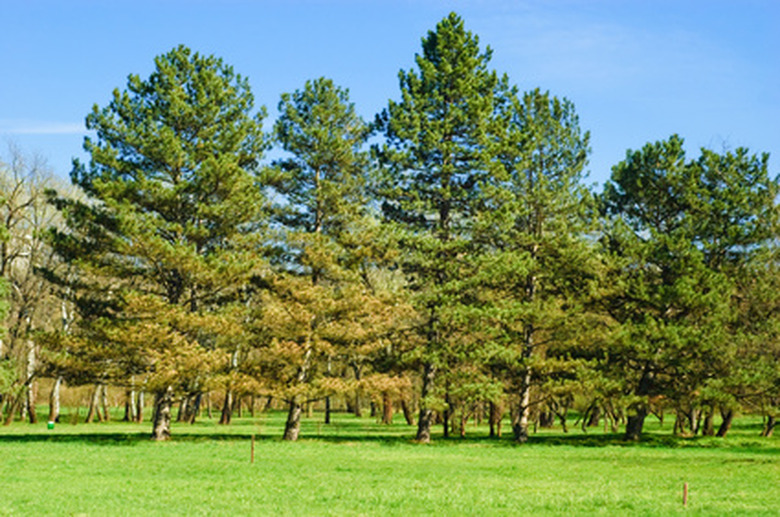Natural Fertilizer For Pine Trees
Pine trees naturally have a self-fertilizing cycle where they recycle the nutrients taken from the soil via the pine needles and decomposing twigs found on the forest floor. The fallen pine needles and twigs form a natural blanket to control moisture as they decompose. Pine needles also conserve water on the tree and usually remain in place for up to five years. This cycle is the reason pine trees can survive in harsh, desolate climates that other trees cannot.
Nutrition Requirements
Like most plants, pine trees require three main nutrients: nitrogen, phosphorus and potassium. Calcium, magnesium and sulfur are also required but in lesser amounts. A slow-release fertilizer is more effective at matching the needs of the individual tree. Natural fertilizers are made to be slow-release and require interaction with soil and microbes. The nutritional value of natural fertilizers can be found by reading the label. These values are expressed as percentages of each of the three main nutrients: nitrogen (N), phosphorous (P) and potassium (K), in that order. For example, a product labeled 10-5-5 would contain 10 percent nitrogen, 5 percent phosphorous and 5 percent potassium.
- Pine trees naturally have a self-fertilizing cycle where they recycle the nutrients taken from the soil via the pine needles and decomposing twigs found on the forest floor.
- A slow-release fertilizer is more effective at matching the needs of the individual tree.
Types
Various natural fertilizers can be found for pine trees. Cottonseed meal is most used for acid-loving plants such as pines. Blood meal, nitrogen-rich supplemental fertilizer, is dried and powdered blood from cattle. Fish emulsion is a blend of decomposed fish that has been pulverized. Manure is a complete fertilizer containing all essential elements but at very low levels; manure is often used as a supplement instead of a stand-alone fertilizer. Composted sludge from sewer facilities is also used as fertilizer because of its high concentration of nutrients; this fertilizer is found in dry, granular form.
The Need
Deborah Brown of the University of Minnesota Extension recommends observation of the growth rate and needle color for specific pine trees to determine if fertilizing is necessary. Under normal conditions, pine trees use the natural decomposition process of pine needles and twigs to replenish nutrients into the soil. If the ground around cultivated pine trees is cleared periodically, then fertilizing may be necessary. Look for sparse or slow growth and dull or browning needles.
- Various natural fertilizers can be found for pine trees.
- Composted sludge from sewer facilities is also used as fertilizer because of its high concentration of nutrients; this fertilizer is found in dry, granular form.
Testing
Soil testing should be conducted before applying any type of fertilizer. A local extension service can conduct this test to tell what nutrients are lacking and the proper amounts to apply for corrective action. Since pine trees favor acidic soil, sulfur may be used to naturally raise the acid level. Cottonseed and fishmeal can be combined as a medium-release fertilizer to help stabilize acidic soil; a range of 7-3-2 for cottonseed and between 6-3-2 and 12-7-5 for fishmeal is sufficient.
Application
The roots of young pine trees are prone to issues from over-fertilization. Bowen recommends fertilizing in early spring before new growth, although fertilizer can be applied up until midsummer. Fertilizer should be applied yearly for new trees until they are established and the nutrition cycle sets in. Yardener.com recommends applying fertilizer from the base of the tree to a distance equal to 1 1/2 times the distance between the trunk and the end of the branches. So, if the tree is 20 feet wide, you would fertilize up to 30 feet from the trunk (20x1.5), keeping the fertilizer from touching the trunk. Mulching around pine trees diminishes the need to fertilize because mulch provides much of the nutrients required through continuous decomposition.
- Soil testing should be conducted before applying any type of fertilizer.
- Mulching around pine trees diminishes the need to fertilize because mulch provides much of the nutrients required through continuous decomposition.
